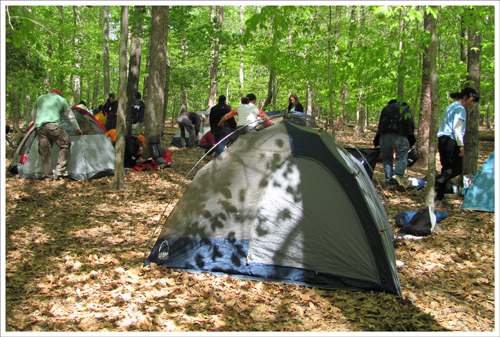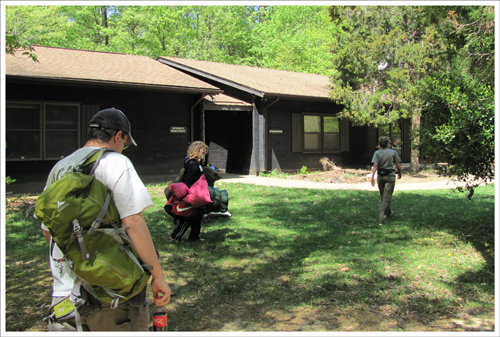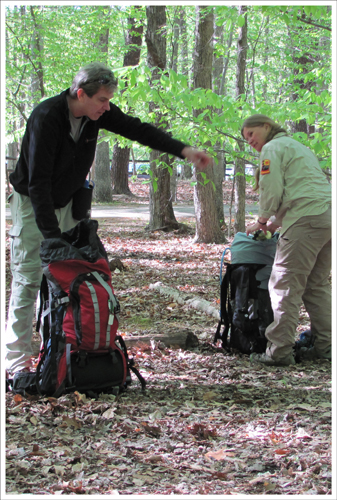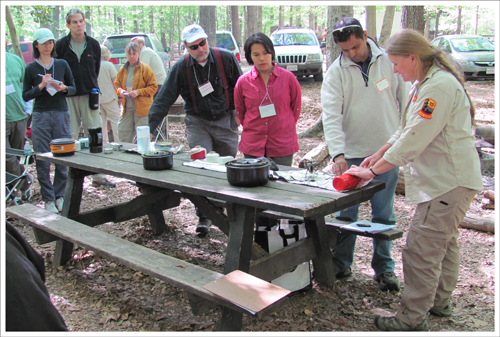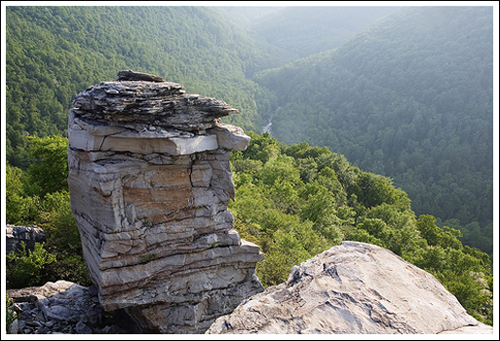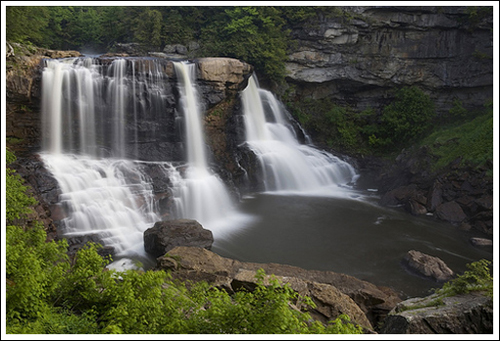 The last time we did a gear review it was 2010 and we were brand new to backpacking! We bought a lot of our gear based on reviews, recommendations, and cheap prices. In the five years since then, we’ve made a lot of changes to what we carry on overnight trips. We’ve both managed to make our loads significantly lighter!
The last time we did a gear review it was 2010 and we were brand new to backpacking! We bought a lot of our gear based on reviews, recommendations, and cheap prices. In the five years since then, we’ve made a lot of changes to what we carry on overnight trips. We’ve both managed to make our loads significantly lighter!
Gear List – The Basics
| 2015 | 2010 |
|---|---|
| Pack: Gregory Z65 (Adam) This pack has served well, but due to wear-and-tear (including mouse-eaten hipbelt pockets), 2015 will probably be this pack’s last year on the trail. Overall has fit well and does allow for air to get between your back and the pack, which is a great feature to keep you cool. |
Same |
| Pack: Osprey Aura AG 50 (Christine) The Z55 I was using is designed for a man and never really fit me properly. I tried an Osprey Viva 65 in 2014. It was a decent pack, but had more capacity than I needed. I also found that the pack’s simple suspension made it ride heavier than what was comfortable. The new Osprey anti-gravity suspension technology is nice and I’ve really been enjoying carrying this pack. Sometimes 50 liters is a tight squeeze, but it forces me to make wise packing choices. The only things I don’t care for are the center-back placement of the water port and the split compartment in the pack lid. The water port is too tight and it’s proximity to the frame makes it hard to shove the drinking hose through the opening. The split compartment lid means the compartments are both smaller. One large compartment would have been better for me personally because I like to stow my snack bag in the pack lid. Sometimes I have a hard time fitting my treats in either of the smaller zippered areas. |
Gregory Z55 (Christine) |
| Tent: Big Agnes Copper Spur UL2 In 2014, we upgraded our tent and saved over 3.5 pounds of pack weight. The Copper Spur is certainly a tight fit for two tall(ish) people, but the saved weight is worth it for more comfortable trail miles. The tent fits compactly inside Adam’s pack and he no longer has to strap our shelter to the outside of his pack. Honestly, we only notice the tightness of the space for a few minutes while we’re falling asleep, but once we’ve drifted off the small quarters are fine. |
Mountain Hardware Drifter 3 |
| Sleeping Bag: L.L. Bean Semi-Rectagular Down (Adam) This used to be Christine’s bag, but we traded so she would stay warmer. I sleep hot, so the trade worked out well for both of us! Easy to get in and out and compresses down nicely in the pack. |
Traded |
| Sleeping Bag: Sierra Designs Tomichi (Christine) Adam and I traded bags because this one is just a little warmer due to the tighter mummy fit. When I first started out, I didn’t like the snugness of a mummy, but now I do. It’s cozier and I stay warmer. Both of our bags are considered ‘summer bags’, but they’ve always been warm enough for spring/summer/fall in Virginia. We also have silk Cocoon liner for added warmth if needed. When it’s really warm in summer, we both leave sleeping bags home in favor of a Thermarest sheet and tech blanket. We don’t camp when it’s cold, so we don’t own winter bags. |
Traded |
| Sleeping Pad: Big Agnes Insulated Air Core We both have and really like this pad. It has served well and we plan on continuing to use them. |
Same |
| Water Purification: Sawyer Mini In 2015, we switched to a Sawyer Mini after seeing most thru-hikers favoring them over older style pump filters. We really like it. We bought both 32 and 64 oz pouches. The carry weight is almost nothing. The unit requires no assembly and very little field maintenance. We store the Sawyer in an easily accessible spot in our pack and can quickly filter water at any source we cross. The ease-of-use factor means we’re carrying less water in our packs. The weight savings between 3 liters of water and a liter and a half of water is mind blowing! The only challenge is when there are just standing water sources. Non-flowing water would be a challenge to expand the bag. We also carry Aquamira as a backup. And yes… Christine is still paranoid about giardia and feels a little creeped out drinking water from random streams and springs in the woods. |
Katadyn Hiker Pro |
| Hydration: Camelbak 3L We both carry a 3L Camelbak in our pack. Christine usually carries about 1.5 liters of water. Adam carries a bit more. We like having the extra capacity so we can stock up on water if we’re going to be hiking across a dry area. We both also carry an empty, light plastic bottle (like SmartWater). Disposable-type plastic bottles weigh nothing and are handy to have for mixing drink powder into water at camp. We both get tired of plain water and like having a bottle to mix lemonade or Gatorade powder for a flavored drink with dinner. |
Nalgene bottles and Camelbaks |
| Stove: JetBoil We like our JetBoil. It’s compact, boils water quickly, and is easy to use. We don’t ‘cook’ at camp. Everything we eat simply requires the addition of boiling water, so we like the simplicity of this all-in-one system over a separate cookpot and stove. |
Same |
Other Bits & Pieces
- Trail Comfort: Trekking Poles. We are both still using the same trekking poles we had in 2010. Neither of us can imagine ever hiking without them. They take so much strain off your knees and make it easier to balance with a pack on uneven terrain.
- Camp Comfort: Crocs. Yes, they are still dorky, but you can’t beat their weight or comfort around camp (as long as you wear them with socks).
- Camp Comfort: Headlamps. We both have good quality (Petzl/Black Diamond) headlamps.
- Safety: Downsized First Aid Kit. We used to carry a large, fully-stocked first aid kit — just in case. It was quite heavy and essentially had larger quantities of the items in a smaller kit. Now we carry a small kit with bandages, gauze, blister care, painkillers, antihistamines, anti-bacterial wipes/ointment, cortisone cream, anti-diarrheal, tweezers, and duct tape. It fits in a small case about the size of a hand and covers all the basics and necessities. It’s a calculated risk to not have splints, large ace bandages, scissors, safety pins, and a manual – but it saves a pound of pack weight.
- Safety: Dealing with Ticks. We treat our clothes and gear with Sawyer Permethrin throughout spring, summer, and fall. Lyme disease is becoming more prevalent, and permethrin reduces the risk of having ticks attach. We spray our shoes, socks, hiking clothes, and camp/sleep clothes. If we’re going somewhere that’s very dense and brushy, we also use DEET on bare skin.
- GPS Unit: Unnecessary. Adam used to carry a Garmin handheld GPS unit. Now we just carry a compass, printed map of the area/AWOL Guide page, and a smartphone. We used to bring those items in addition to the GPS unit and found it redundant. We use the MapMyHike app on our phone to help with calculating routes and either carry maps or pre-print routes using AllTrails.com.
- Space Saver: Compression Sack. Instead of just a regular stuff sack, we now use Sea to Summit compression sacks for our sleeping bags. It makes them really compact and small. Why did we wait so long to get these?
- Comes in Handy Often: Collapsible Bucket. When water is running low or slow, the Sea to Summit bucket makes it easy to gather a large amount of water at once. We can then take water back to camp for filtering and cooking at our leisure. The bucket is free standing, weighs 2.8 ounces, and holds 10 liters of water.
- Luxury Item We Carry: Alite Monarch chairs. I know that chairs seem like a waste of pack weight and space to some. Yes… the chairs add a little over a pound (1 pound, 5 ounces to be specific) to our load. Many would point out that you can sit on the ground, lean against a tree, or use your pack as a backrest. While all these things may be true, nothing beats being able to be off the ground and semi-reclined with back support after a long day on the trail. Christine went chairless on an overnight earlier this year. She regretted it.
- Luxury Item We Carry: Cocoon Ultralight pillows. A lot of people will use their clothes bag, a jacket, or empty pack for a pillow. We found all of those options to be too slick and lumpy. Cocoon’s pillows pack down smaller than the size of a fist and weigh less than 6 ounces. It’s another luxury item that we find well worth carrying.
- Luxury Item We Carry: Thermarest sheet. It’s just 4 ounces and it makes laying on the sleeping pad a lot more comfortable. You never feel sticky or clammy with the sheet.



































 Finding good backpacking gear seems to be an exercise in trial and error. Preferences are wildly varied and highly subjective, so we thought it would be fun and informative to share our gear assessments as we go along.
Finding good backpacking gear seems to be an exercise in trial and error. Preferences are wildly varied and highly subjective, so we thought it would be fun and informative to share our gear assessments as we go along.
